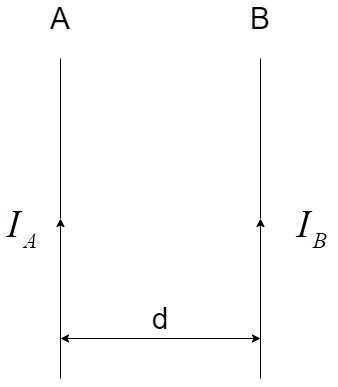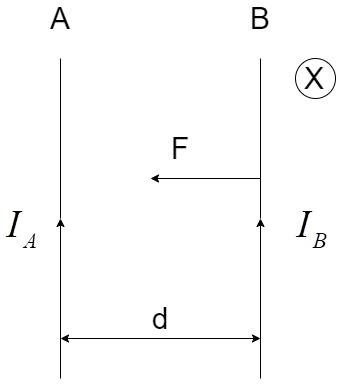Question
Question: Derive the formula for the force acting between two parallel current carrying conductors....
Derive the formula for the force acting between two parallel current carrying conductors.
Solution
Before we proceed to derive the expression for force acting between two current carrying parallel conductors, we should be familiar with the expression for the Biot-Savart’s law which gives the expression for magnetic field at a point due to a current carrying conductor, as follows –
dB=4πμ0r3I⋅dl
where I = current in the circuit, dl= length of the current element, r = distance of the point from the current element.
Complete step by step solution:
Consider two conductors A and B of infinite length, with currents IA and IB in the same direction and separated at a distance of d, as shown:

The current IA results in a magnetic field BA at the conductor B, at the distance of d, which is given by applying the Biot-Savart’s law for a conductor carrying current.
BA=4πμ0d2IA
Whenever a current carrying conductor is placed in an external magnetic field, there is a force acting on it and the force experienced by the conductor is equal to the product of magnetic field, current and the length of the conductor.
F=BIL
The conductor B experiences force due to the magnetic field produced by the conductor A, which is given by BA.
Therefore, the force acting on the conductor B will be equal to –
⇒F=BAIBL
Substituting the value BA , we have –
⇒F=4πμ0d2IAIBL
Therefore, the force per unit length between two parallel conductors is given by the expression:
⇒f=LF=4πμ0d2IAIB
The direction of the force can be calculated by using the Fleming’s Left Hand rule where:
i) Index finger represents the direction of the magnetic field, B
ii) Middle finger represents the direction of the current, I
iii) Thumb represents the direction of the force, F
The direction of the force is represented in the diagram below:

Here, the direction of BAis calculated by the Right-Hand screw rule, which gives the result that the direction of the magnetic field is inside the plane of paper and denoted by X.
Note: The standard definition of the SI unit of current, ampere is defined by the help of the derived expression as follows:
If IA=IB=1A and d=1m, we have –
⇒f=4πμ0d2IAIB=10−7×12×1×1=2×10−7N
Thus, One ampere is defined as the steady current, which when maintained between two infinitely long conductors with unit separation, would produce a force per unit length equal to 2×10−7N.
